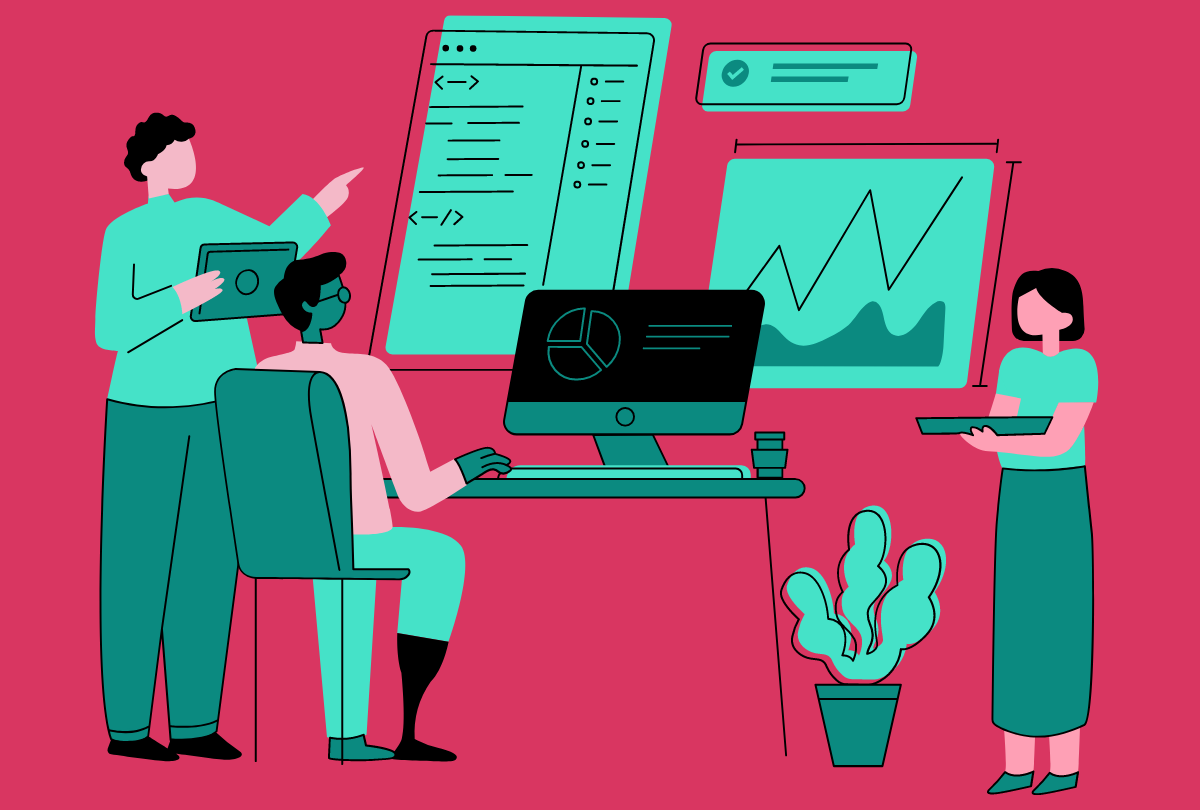The saying, “One should never stop learning” is vital to life. To stop learning is to stop growing – and investing in employee growth is vital to business growth, and frankly the sign of a company that truly cares about its workers.
An important step in any type of growth is making and achieving goals, and professional development is no different. Professional development goals are critical to keeping you motivated, understanding where you’re headed, and figuring out how to get there.
In today’s climate of constantly changing skills, L&D programs are at the heart of creating and managing employee development goals. Helping your employees create those paths and enabling them to achieve those goals through coaching and mentoring are becoming increasingly important in a fast-changing business environment. It’ll go a long way in both developing your employees and your organization.
What Are Professional Development Goals?
Professional development goals (AKA KPIs, or key performance indicators) are the objectives and metrics that are applied to courses taken as part of a professional development program.
Workplace professional development is the courses and similar initiatives that improve the professional skills of employees. The material and skills learned by employees during these programs are vital to their long-term careers. Professional development can range from topics such as executive and leadership development all the way down to basic abilities such as IT system usage and time management skills.
Of course, there are people who arrange their own courses to, for instance, start a totally new career. But professional development can – and should – be an HR issue. By leading the initiative, various organizational goals can be met (see below).
Note as well that professional development goals are a subset of professional goals. This is an essential difference because development goals are part of an L&D program. In contrast, a professional goal example can be moving to a different organization, something in which an employee’s current company would not be involved.
Professional Development Goals vs. Employee Development Goals
Employee development covers a wide range of activities that apply to all workers. Employee development goals can include everything from gaining production line skills through an onboarding program to handling a public market offering by giving the CEO a specialist mentor. The main contrast is that a professional development goal will help an employee throughout their career, whereas employee development goals will also include training in activities that are specific to their organization.
Why Are Professional Development Goals Important?
L&D programs cost money. By 2030, global expenditure on corporate training is forecast to reach almost 500 billion USD. If that level of cash were spent on, for instance, technical infrastructure, businesses would want to see proof of value.
But it’s not so easy with L&D programs. It can be difficult to know if a particular course has improved somebody’s abilities, especially when it comes to soft skills. For instance, ‘communication’ is an important soft skill, but what makes a good communicator? There are many types of communication, and moreover, people have different ideas about the styles of communication which they prefer. At the same time, because they are vital, no HR department should refuse to provide such courses. What has happened as a result of this challenge is that many companies provide courses, but don’t set goals that examine changes in employee behavior in terms of productivity.
Still, this situation is not acceptable; it is simply not a good business practice to invest in something without some kind of cost-benefit analysis. Instead, by setting and measuring professional development goals, organizations can obtain the following benefits:
Performance Assessment
While it is difficult to accurately measure the benefits of L&D. There are, however, many frameworks that enable some kind of assessment, including Anderson’s Model of Learning Evaluation, the Phillips ROI Model, and Kirkpatrick’s Four-level Training Evaluation Model. These frameworks can go a long way toward establishing the value of professional development programs.
Employee Satisfaction
Employees put effort into development programs and want to see the results of their work. In fact, the availability of workplace L&D courses is one of the most important factors for retention. By measuring employee performance, you are either confirming that their skills are better (as are their chances for promotion) or that they need more development (which shouldn’t be a problem for workers with a Growth Mindset).
Program Improvement
When employees do well in a professional development course, it’s often the course itself (as well as the instructor) that is a factor in success. Alternatively, poor grades can mean that you need to examine essential performance metrics and potentially look for new coaches, mentors, or technical trainers.
Professional Goals from the Company’s Point of View
Employees create professional development goals based on their career ambitions. However, HR and the organization tend to have a much wider set of needs. In general, you will find that employees who are part of a company’s professional development program are acquiring skills in one (or more) of these areas:
Strategic Requirements
When forming a strategy, executives often need more employees, as well as new worker skill sets. HR has the option to hire new staff with the desired skills. But they might also recruit internally, which delivers many advantages including lower costs and faster onboarding times. However, internal hires often need to upgrade their professional skills to suit new and/or revised operations that are part of the strategy.
Upskilling
Even when there are no fundamental strategic moves at a company, there is still an almost constant need for upskilling. This is due to the rapid rate of skills turnover. According to Gartner, for instance, the number of skills required for a particular job is increasing by 5.4% annually. At the same time, other skills are quickly becoming obsolete, with 33% of the skills for an average job posting in 2019 not being needed by 2024.
Performance Improvement
Not every employee has a smooth career path. Some will need to boost their skills as a result of poor performance, and that will often involve some type of remedial training. When professional skills are involved, such workers benefit from strengthening the abilities that will serve them in the long run.
Succession
Smart companies prepare for the unavoidable turnover that is due to retirement, promotions, and other factors, through a succession plan. Clearly, not every employee listed in the plan will be ready to take on new responsibilities, and professional development serves the goal of making them ready for new skill demands.
Examples of Professional Development Goals
It’s when looking at professional development goal examples that a critical distinction should be mentioned. There is often confusion between the related concepts of goals and plans.
A goal is what you want to achieve, while a plan, course, or experience is how you get there. At times, professional development goals are described as learning about a new subject, obtaining a degree, or acquiring leadership skills. But this is misleading. Employees and organizations that are building skills for the future are interested in results, not learning for its own sake.
For instance, to use the above case, some employees take communication courses. But “learning how to communicate” is not a goal. Instead, while setting professional development goals, it’s vital to define exactly what the employee/organization wants to achieve, and how it will be measured.
So, taking the instance of communication, a goal might be expressed as:
- Writing clear emails
- Making an effective presentation
- Explaining a change management initiative to employees
Measuring Goal Attainment
But how do you assess “writing clear emails?” This is a subjective skill that will be difficult to evaluate, but there are actually a variety of ways to do this:
Training Effectiveness
Measuring training effectiveness takes a “big picture” approach and involves:
- Applying one of the assessment models described above
- Collecting pre- and post-course behavior data through evaluation forms, interviews, and feedback sessions
- Processing the results in a way that is useful for future reference (no HR person wants to read pages of data for every employee and every course that they take)
The advantage of this method is that it allows you to understand the quality of a course from the viewpoint of many stakeholders and gather a comprehensive amount of data about it. For HR departments that are looking to establish and/or revamp L&D programs on a large scale, this approach is recommended.
Employee Development
A second process for measuring goals concentrates on an individual’s accomplishments. By measuring employee development in the Growthspace way, you can quickly assess the progress that a worker has made once they complete a course and apply their skills. It goes like this:
- Employees are asked to grade six aspects of the program according to a 1-5 scale
- Managers are asked (again, using a 1-5 scale):
- How much did the program impact the selected KPI?
- How did the program perform with regard to the challenge, overall performance, and motivation?
- Would you recommend this program to other employees/managers?
The result is a numerical score that can be easily understood and copied into the employee’s record and L&D-related documents. But most importantly, it lets you know how well the worker meets organizational KPIs for essential skills and if an important skill gap has just been closed.
Setting Professional Development Goals
Goal setting for professional development courses is a critical aspect of planning. In brief, here is how these two activities are related:
Step 1 – Skills gap analysis
The first step of a professional development plan is to conduct a skills gap analysis. This results in a list of skills that the organization needs, and which is cross-referenced with the career path (and resulting abilities) that employees want. Specific skills need to be cited in the analysis (see “examples of professional development goals”).
Step 2 – Choosing courses and goals
HR’s next task is to arrange various courses for skills training and then connect measurable goals to them (as stated above, many companies don’t link business goals to courses at this stage, but it’s actually imperative in order to obtain a development program’s full advantages). Once courses and goals are set, HR then needs to source experts (coaches, mentors, and technical trainers) and set up the courses.
Step 3 – Evaluation
This is the last step covered, but the evaluation process actually starts before an employee goes to the course. HR should assess their abilities in the chosen skill area to establish a baseline. Then, once the course is over, the same assessment is applied to determine improvements. Some organizations also perform an evaluation at the midpoint of a course (to check if changes need to be made) and some time afterward (to measure knowledge retention).
Scalable Professional Development Goals for Growth
The process of defining and measuring goals takes time and expertise, especially in a large organization, where hundreds of employees might need professional development planning. Legacy learning management systems don’t have the ability to create or track goals at that level.
But leading talent development platforms do. Instead of “shoehorning” goals into a professional development program because it’s a good idea, a talent development platform starts every course by setting KPIs. According to what the program is meant to achieve – such as increased engagement, performance, or managerial satisfaction – the goal is set based on measurable business or organizational needs. Then, once the course has ended, the program’s KPI is compared to the scores of a control group to determine success.
Along with this ability, talent development technology enables administration functions and acts as an interface for matching experts. In sum, such platforms are a must-have for any company that understands the value of effective professional development.




